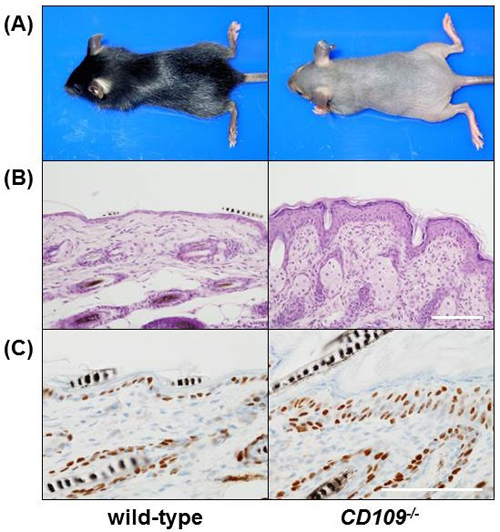Skin abnormalities in mice lacking CD109B6.129S6-Cd109<tm1Mat>/MatRbrc (RBRC05911)Courtesy of Masahide Takahashi, M.D., Ph.D. (A) Macroscopic images of wild-type and CD109-/- mice at postnatal day 28 (P28). CD109-/- mice show hair growth impairment at approximately P28. (B) H&E-stained skin sections of wild-type and CD109-/- mice at P28. Hyperplasia of the epidermis and sebaceous glands is observed. (C) Immunohistochemical analysis using an anti-p63 antibody in the skin of wild-type and CD109-/- mice. The epidermis of CD109-/- mice shows apparent thickening of the basal/suprabasal layer, which is positive for the basal cell marker p63. Scale bars: 100 µm. |
The glycosylphosphatidylinositol (GPI)-anchored glycoprotein CD109 is a member of the α2-macroglobulin/C3, C4, C5 family. CD109 immunoreactivity is detected on oral, esophagus, lung, and uterus squamous cell carcinoma. In normal tissues, CD109 is expressed on myoepithelial cells of the breast, salivary, lacrimal, and bronchial secretary glands and basal cells of the prostate and bronchial epithelia [1-6]. It is also expressed on phytohemagglutinin-activated T lymphoblasts, thrombin-activated platelets, endothelial cells, and a subset of CD34+ bone marrow mononuclear cells.
CD109 downregulates transforming growth factor beta (TGF-β) signaling by promoting TGF-β receptor localization into lipid rafts and caveolae. CD109 is produced as a 205-kDa glycoprotein, which is then processed in the Golgi apparatus into 180-kDa and 25-kDa proteins by furinase. This cleavage is required for the association of CD109 with TGF-β receptor I, thereby negatively regulating the TGF-β signaling pathway [7]. Takahashi and colleagues generated CD109-deficient/lacZ-knock-in mice to investigate the physiological roles of CD109 in vivo and revealed that CD109-deficient mice showed kinked hair shafts, ectatic hair follicles with an accumulation of sebum, and persistent hyperplasia of the epidermis and sebaceous glands. Although CD109 deficiency did not induce any changes in Smad2 phosphorylation levels in the epidermis, Stat3 phosphorylation was significantly elevated compared with wild-type mice [8]. Therefore, CD109 plays a key role in the normal development of the skin via a Stat3-mediated pathway. These results were also mentioned in the review article on CD109 functions [9].
| Depositor | : | Masahide Takahashi, M.D., Ph.D. Department of Pathology, Nagoya University Graduate School of Medicine |
|
| References | : | [1] | Hashimoto M, Ichihara M, Watanabe T, Kawai K, Koshikawa K, Yuasa N, Takahashi T, Yatabe Y, Murakumo Y, Zhang JM, Nimura Y, Takahashi M. Expression of CD109 in human cancer. Oncogene; 23(20):3716-20, 2004. |
| [2] | Zhang JM, Hashimoto M, Kawai K, Murakumo Y, Sato T, Ichihara M, Nakamura S, Takahashi M. CD109 expression in squamous cell carcinoma of the uterine cervix.Pathol Int; 55(4):165-9, 2005. | ||
| [3] | Hasegawa M, Hagiwara S, Sato T, Jijiwa M, Murakumo Y, Maeda M, Moritani S, Ichihara S, Takahashi M. CD109, a new marker for myoepithelial cells of mammary, salivary, and lacrimal glands and prostate basal cells.Pathol Int; 57(5):245-50, 2007. | ||
| [4] | Sato T, Murakumo Y, Hagiwara S, Jijiwa M, Suzuki C, Yatabe Y, Takahashi M. High-level expression of CD109 is frequently detected in lung squamous cell carcinomas. Pathol Int; 57(11):719-24, 2007. | ||
| [5] | Hasegawa M, Moritani S, Murakumo Y, Sato T, Hagiwara S, Suzuki C, Mii S, Jijiwa M, Enomoto A, Asai N, Ichihara S, Takahashi M. CD109 expression in basal-like breast carcinoma.Pathol Int; 58(5):288-94, 2008. | ||
| [6] | Hagiwara S, Murakumo Y, Sato T, Shigetomi T, Mitsudo K, Tohnai I, Ueda M, Takahashi M. Up-regulation of CD109 expression is associated with carcinogenesis of the squamous epithelium of the oral cavity.Cancer Sci; 99(10):1916-23, 2008. | ||
| [7] | Hagiwara S, Murakumo Y, Mii S, Shigetomi T, Yamamoto N, Furue H, Ueda M, Takahashi M. Processing of CD109 by furin and its role in the regulation of TGF-beta signaling. Oncogene; 29(15):2181-91, 2010. | ||
| [8] | Mii S, Murakumo Y, Asai N, Jijiwa M, Hagiwara S, Kato T, Asai M, Enomoto A, Ushida K, Sobue S, Ichihara M, Takahashi M. Epidermal hyperplasia and appendage abnormalities in mice lacking CD109.Am J Pathol; 181(4):1180-9, 2012. | ||
| [9] | Mii S, Enomoto A, Shiraki Y, Taki T, Murakumo Y, Takahashi M. CD109: a multifunctional GPI-anchored protein with key roles in tumor progression and physiological homeostasis. Pathol Int. 2019 May;69(5):249-259. | ||






